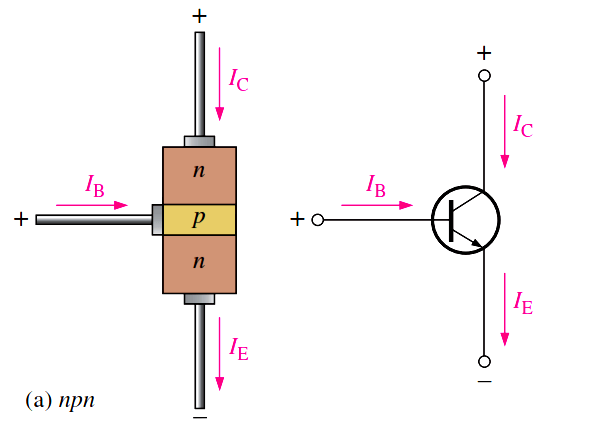The below Figure shows a bias arrangement for both npn and pnp BJTs for operation as an amplifier. Notice that in both cases the base-emitter (BE) junction is forward-biased and the base-collector (BC) junction is reverse-biased. This condition is called forward-reverse bias.

Fig : Forward-reverse bias of a BJT.
Operation :
To understand how a transistor operates, let’s examine what happens inside the npn structure. The heavily doped n-type emitter region has a very high density of conduction-band (free) electrons. These free electrons easily diffuse through the forward based BE junction into the lightly doped and very thin p-type base region, as indicated by the wide arrow. The base has a low density of holes, which are the majority carriers, as represented by the white circles. A small percentage of the total number of free electrons injected into the base region recombine with holes and move as valence electrons through the base region and into the emitter region as hole current, indicated by the red arrows.
When the electrons that have recombined with holes as valence electrons leave the crystalline structure of the base, they become free electrons in the metallic base lead and produce the external base current. Most of the free electrons that have entered the base do not recombine with holes because the base is very thin. As the free electrons move toward the reverse-biased BC junction, they are swept across into the collector region by the attraction of the positive collector supply voltage. The free electrons move through the collector region, into the external circuit, and then return into the emitter region along with the base current, as indicated. The emitter current is slightly greater than the collector current because of the small base current that splits off from the total current injected into the base region from the emitter.
Transistor Currents
The directions of the currents in an npn transistor and its schematic symbol are as shown in Below Figure (a); those for a pnp transistor are shown in Figure Below (b). Notice that the arrow on the emitter inside the transistor symbols points in the direction of conventional current. These diagrams show that the emitter current (IE) is the sum of the collector current (IC) and the base current (IB), expressed as follows:
![]()
IB is very small compared to IE or IC. The capital-letter subscripts indicate dc values.

